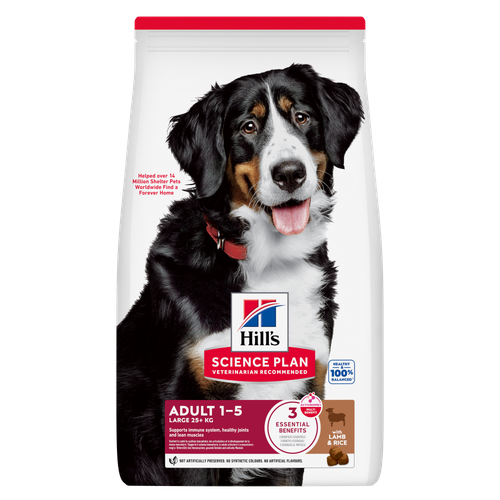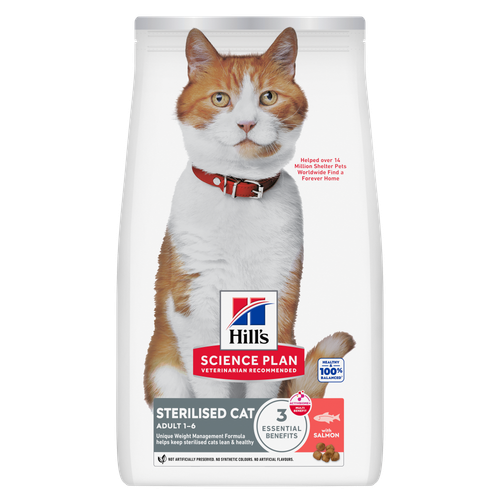
-
Find the right food for your petTake this quiz to see which food may be the best for your furry friend.Find the right food for your petTake this quiz to see which food may be the best for your furry friend.Featured products
 Adult Light Dog Food
Adult Light Dog FoodHill's Science Plan Light Adult Wet Dog Food is a complete premium pet food for adult dogs that tend to gain weight easily. This deliciously smooth loaf is formulated to deliver the appropriate amount of energy to support weight maintenance in adult dogs.
Shop Now Perfect Digestion Large Breed Puppy Food
Perfect Digestion Large Breed Puppy FoodPrecisely balanced nutrition with Hill's ActivBiome+ prebiotic blend actively contributes to supporting digestive health and overall wellbeing to help your pet feel their best
Shop Now Large Breed Adult Dog Food
Large Breed Adult Dog FoodHill's Science Plan Large Breed Adult Dog Food with Lamb & Rice is a complete pet food, specially formulated with ActivBiome+ Multi-Benefit Technology.
This food is specifically designed to fuel the energy needs of large breed dogs during the prime of their life.Shop NowFeatured products Adult Cat Food
Adult Cat FoodHill's Science Plan Adult Cat Food with Chicken is a complete pet food, specially formulated with ActivBiome+ Multi-Benefit Technology.
This food is specially formulated to fuel the energy needs of cats during the prime of their life.Shop Now Sterilised Adult Cat Food
Sterilised Adult Cat FoodHill's Science Plan Adult Sterilised Cat Dry Food with Salmon is specially formulated with ActivBiome+ Multi-Benefit Technology. It is a precisely balanced nutrition, tailored to meet the needs of sterilised cats, to help keep sthem lean & healthy.
Shop Now CULINARY CREATIONS ADULT CAT FOOD
CULINARY CREATIONS ADULT CAT FOODHill's Science Plan CULINARY CREATIONS Adult cat food with Salmon & Carrots was formulated to provide a great-tasting experience to cats. Its delicious flavour and texture are combine with essential nutrients to support cats' optimal health during the prime time of their life. Specially formulated with high-quality salmon protein, essential taurine for heart health & balanced minerals to support kidneys & bladder.
Shop Now -
Dog
- Dog Tips & Articles
-
Health Category
- Weight
- Food & Environmental Sensitivities
- Urinary
- Digestive
- Joint
- Kidney
-
Life Stage
- Puppy Nutrition
- Adult Nutrition
- Senior Nutrition
Cat- Cat Tips & Articles
-
Health Category
- Weight
- Skin & Food Sensitivities
- Urinary
- Digestive
- Kidney
-
Life Stage
- Kitten Nutrition
- Adult Nutrition
Featured articles Pet Nutrition: What Makes "Healthy" Pet Food Healthy? | Hill's Pet
Pet Nutrition: What Makes "Healthy" Pet Food Healthy? | Hill's PetIn people, the right diet is very important. If you are eating the wrong way for your metabolism, activity level, age and lifestyle you could end up with health issues.
Read More Microchipping: The Facts | Hill's Pet
Microchipping: The Facts | Hill's PetThe government has announced that as of April 2016, all dogs in the UK must be microchipped by law.
Read More The Incredible Science Behind Your Pet's Microbiome
The Incredible Science Behind Your Pet's MicrobiomeLearn what your pet's microbiome is, how it contributes to your pet's gut and overall health, and why nutrition is important in maintaining healthy microbiomes.
Read More -


Being overweight or obese is a big problem these days for humans and animals alike. Around 40% of cats and dogs in Europe are thought to be overweight or obese. With busy lives, it’s easy for our weight to gradually creep up, too. Foods designed for weight loss or weight maintenance might help with a weight loss plan for your dog but exercise is really important for both of you, too.
Do you have a personal weight loss goal? If so, you've probably heard that the best way to stick to your health plans is to have a weight-loss buddy. Your dog may be the perfect choice for a fitness pal, especially if they could do with losing some weight themselves. Not sure what a healthy dog should look like in the first place? Read on for everything you need to know about training with your dog.
Signs your dog is overweight
If you’ve noticed your dog has been less active lately, it may be a sign that they’re becoming overweight or lacking in energy. Other signs of a pudgy pooch include shortness of breath, having to loosen their lead or collar, and no longer seeing an obvious "waist" behind their ribs. However, you should always talk to your veterinarian about what a healthy weight should be for your dog. Don't rely on the internet or a friend to tell you if your pet should be losing weight.
There may be many reasons a dog becomes overweight. Some health conditions, such as heart disease, can also be marked by exercise intolerance, notes the PDSA. With this in mind, always speak to your vet before simply going for a weight loss plan. It could be dangerous to diet a sick animal and with all health issues, the sooner they are diagnosed, the better. Whatever the cause, your vet is the best person to determine the most suitable course of action.
If your dog is a healthy weight or just starting to get a little tubby, now is the best time to act! Once your dog becomes overweight or obese, some of the related health issues may be irreversible, and it’s always easier to prevent weight gain than to lose weight afterwards.
The PDSA estimates that nearly half of dogs in the UK are overweight, putting them at risk of health disorders like:
- Joint problems.
- Breathing issues.
- Skin problems.
- Kidney disease.
- Heart disease.
- Diabetes.
- Shortened life expectancy.
But the good news is that taking steps toward establishing a regular fitness routine can help your fluffy companion live a longer, happier life. Remember that a kilogram or two overweight may not seem like a lot to you, but to smaller dogs it could be the same as 10 kilograms to you. It's best to not think about your dog's weight in kilos, but rather their body condition score. This is a more accurate way to tell if your dog is overweight and accounts for differences in breed types. Ask your vet or nurse to show you how to assess your dog’s body condition.
Even if your dog doesn't look overweight or still seems to be fairly active, it's a good idea to confirm that they are at a healthy weight before you start an exercise routine for the pair of you. You and your vet can also review the type, amount, and frequency of the food you’re giving your dog.


Tasty Tips
Finding ways for your dog to join in your weight loss goals
Including your dog in your weight loss activities can help boost your motivation to meet your health goals. The extra effort required to make a dog-friendly exercise routine might also spur you to plan out your workout ahead of time, since you'll have to figure out places and activities that will let you and your dog be active together. Scheduling exercise can make it a more integral part of your life and increase the likelihood that you'll follow through. Over time, your dog will pick up on your exercise routine and give you a nudge when it's time to get busy burning calories.
The benefits of exercising with your dog
Net Doctor and other health and fitness experts tout the benefits of staying motivated with a workout partner, but that buddy doesn't have to be human! Spending time with your dog has holistic benefits far beyond your waistline. Dogs have such a good influence on us that they serve as therapy and service animals for people with a wide range of physical and emotional health needs, such as anxiety, post-traumatic stress disorder (PTSD), and post-surgery rehabilitation, according to Patient.info. Whether your dog is a working dog or just a pet, they’re your lifelong companion. Staying focused on losing weight and eating better so you can be a more energetic, healthy pet parent can be a huge personal motivator.

Running and working out is also just another form of playtime for your dog, and when you increase playtime, both you and your pet will burn calories. However, there is another perk to increasing playtime: lower stress levels. Stress triggers the release of the hormone cortisol, which is linked to excess abdominal fat, notes University College London. Reducing stress can help you to prevent weight gain before it even happens.
Whether you’re adding an extra walk each day, creating an obstacle course in your backyard for you and your dog, or just finding a local pet play group to attend together, more time playing as a pair will likely lead to better overall health for you and your furry friend.
Take care
Always talk to your vet before embarking on a new exercise regime with your dog. If your dog is unfit or very overweight, you may need to increase their activity very gradually. And remember, while dogs love to run, they don’t necessarily enjoy running miles and miles like a human. It’s really important for dogs to stop and sniff and explore as well. Extra walks with natural, off-lead exercise are much more fun. And walking is a great way for you to burn calories, too.
When it comes to improving your eating habits, talk to your vet about healthy snacks that might be okay for you and your dog to enjoy together. You and your pup should also increase your water intake and stay hydrated, especially during warm weather. If stress or boredom makes you snack, throw your dog a chew toy before you head to the fridge — and see if your craving is still there after an hour of running around with your pet.
Making the commitment to lose weight and eat better (and getting your dog to do the same) can be a bit overwhelming at first, but having your pet as your weight loss buddy should make things more fun and purposeful. Have fun walking, running, and fetching toward your best results!


One of our staff authors prepared this article for you
Related products

Hill's Science Plan Large Breed Adult Dog Food with Lamb & Rice is a complete pet food, specially formulated with ActivBiome+ Multi-Benefit Technology.
This food is specifically designed to fuel the energy needs of large breed dogs during the prime of their life.

Precisely balanced nutrition with Hill's ActivBiome+ prebiotic blend actively contributes to supporting digestive health and overall wellbeing to help your pet feel their best

Hill's Science Plan Adult Wet Dog Food with Turkey is a complete premium pet food for adult dogs from 1 year. This deliciously smooth minced turkey loaf is formulated to deliver the appropriate amount of energy to support the needs of adult dogs.

Hill's Science Plan Light Adult Wet Dog Food is a complete premium pet food for adult dogs that tend to gain weight easily. This deliciously smooth loaf is formulated to deliver the appropriate amount of energy to support weight maintenance in adult dogs.
Related articles

Learn to see the signs of an upset stomach in your dog, understand the triggers and explore some possible solutions.

Dog obesity is a significant problem - learn more about helping your dog become trimmer and healthier through improved nutrition.
Discover the causes, signs, and treatments of kidney disease in dogs and find methods of supporting your dog's kidney health. Learn more at Hill's Pet.

Gurgling tummies in turmoil are not good news for pets. Owners who have to clean up the unfortunate consequences, digestive problems are one of the rare downsides to owning a pet.

Put your dog on a diet without them knowing
Our low calorie formula helps you control your dog's weight. It's packed with high-quality protein for building lean muscles, and made with purposeful ingredients for a flavourful, nutritious meal. Clinically proven antioxidants, Vitamin C+E, help promote a healthy immune system.
Put your dog on a diet without them knowing
Our low calorie formula helps you control your dog's weight. It's packed with high-quality protein for building lean muscles, and made with purposeful ingredients for a flavourful, nutritious meal. Clinically proven antioxidants, Vitamin C+E, help promote a healthy immune system.

